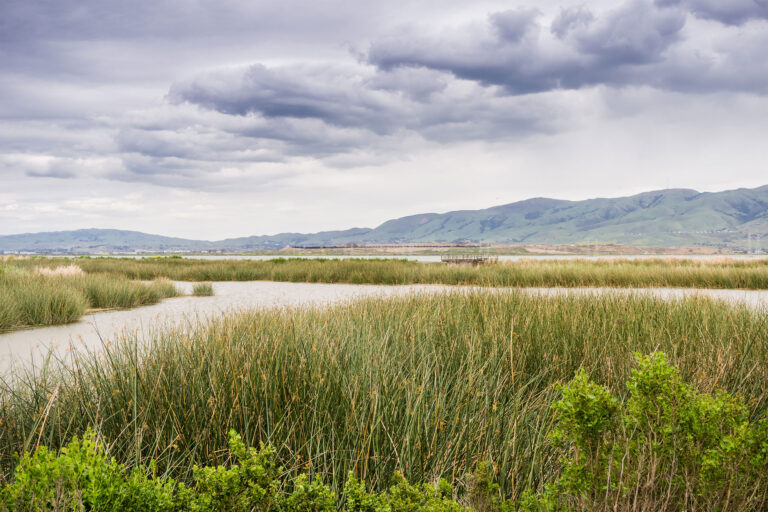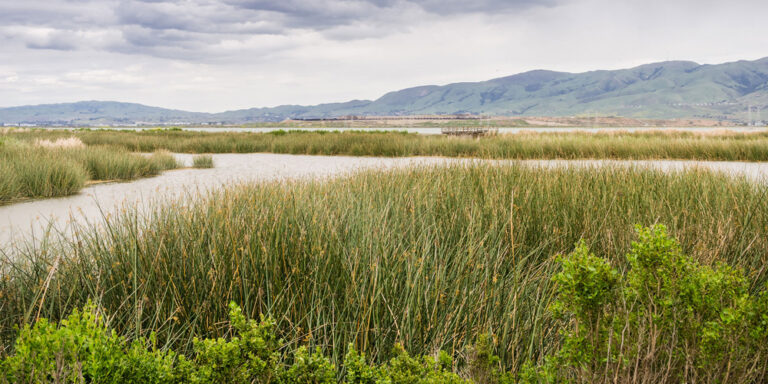Table of Contents
Key Takeaways
California’s ecosystems form the bedrock of the state’s wellbeing and prosperity. Yet many of these ecosystems—which are vitally important to the state’s water supply, agriculture, wildlife, and economy—are in dire health. Climate change and accelerating biodiversity loss threaten to further disrupt these natural systems and the benefits they provide. While the state urgently needs to speed the pace of ecosystem restoration, such projects often find themselves mired in regulations that were originally intended to prevent environmental destruction.
- To scale up and speed restoration, the state needs to reform permitting. To restore ecosystems at the pace and scale needed, California must first address the costly, time-consuming permitting process for restoration projects. The Cutting Green Tape initiative is a promising step in this direction, and more can be done.
- Smarter permitting efforts promote better outcomes. Successful smarter permitting efforts find ways to shorten permitting timelines, lower permitting costs, increase the acreage of restoration projects, and promote better ecological outcomes.
- Regulatory agencies can embrace smarter permitting in three key ways. Within an agency, restoration permitting initiatives can coordinate across similar projects, rather than issuing permits on a project-by-project basis; multiple agencies can coordinate with each other to streamline processes; and agency staff can champion functional permitting, which promotes the restoration of key ecosystem functions across a broad geographical area.
- Project proponents and regulators all have a role to play. Leaders from all sectors can develop inclusive permitting processes that bring stakeholders together to find areas of alignment with a spirit of teamwork. Such processes help develop a culture of trust that allows for flexibility and change, which ultimately leads to resolving conflicts and facilitating ecosystem restoration.
Introduction
California’s varied ecosystems form the bedrock of the state’s wellbeing and prosperity. Yet many of California’s ecosystems are in dire health. A legacy of landscape modifications has disrupted natural processes, reduced the resilience of ecosystem functions, and fragmented and degraded habitats (e.g., San Francisco Estuary Institute 2014). Now, climate change threatens to further disrupt these natural systems, causing severe consequences to human health, wildlife, infrastructure, and economic wellbeing if conditions are not rapidly improved (Sheehan and Tasto 2001; Seavy et al. 2009; Bedsworth et al. 2018). The many benefits that ecosystems provide, some of which are critically important for mitigating climate change and adapting to its impacts, are at risk.
For example, the combination of climate change and the growth of agriculture and urbanization have reduced the freshwater supply to many rivers and decreased the extent of carbon storage in forests, wetlands, and grasslands (Mooney and Zavaleta 2016). California’s wetlands—which stabilize shorelines, improve water quality, and protect against flooding—have largely been lost, with only about 10 percent remaining (California Natural Resources Agency 2010). Furthermore, a multitude of fish and wildlife species are at risk of extinction without intervention (Moyle et al. 2011; Howard et al. 2015). Actions that reverse ecosystem degradation and deliver multiple benefits, such as restoration and mitigation projects, or wildlife-friendly agriculture, are urgently needed. Here we use the term “restoration” broadly to include many different kinds of projects that are intended to improve desired ecosystem functions, such as supporting wildlife or improving water quality.
Significant reform in the regulatory permitting process for projects that benefit the environment is necessary to ensure ecosystems continue to provide critical functions, now and into the future. Currently, permitting is a significant barrier that increases the time, cost, and complexity of restoration projects, sometimes to the point of halting the project altogether or discouraging landowners from participating. California’s environmental permitting system was developed to prevent harm from traditional development projects; unfortunately, it now inadvertently hinders efficient, cost-effective ecosystem restoration in many cases (Robins et al. 2019). This is especially true for wetland and aquatic ecosystems, which have extra protections under the federal Clean Water Act (CWA), the state Porter-Cologne Water Quality Control Act, and the Coastal Act. These ecosystems are often home to endangered species, which have special state and federal protections as well. The permitting process for projects that improve the environment needs to change, while maintaining standards to protect against negative effects.
Various initiatives over the past two decades have sought to improve the permitting process for restoration projects, and recently the state has focused attention on the importance of such reforms. The California Natural Resources Agency (CNRA) launched the Cutting Green Tape initiative in 2019, recognizing ecosystem restoration’s power to address both the biodiversity and climate crises. While anchored in the Natural Resources Agency, Cutting Green Tape efforts are occurring in collaboration with the California Environmental Protection Agency, Department of Food and Agriculture, and State Water Resources Control Board. Cutting Green Tape focuses on improving processes and policies, and increasing granting and regulatory efficiency (see Box 1). These efforts support Governor Newsom’s recently signed executive order, which sets the goal of conserving 30 percent of California’s lands and coastal waters by 2030 (Office of Governor Gavin Newsom 2020). The goal of this report is to support the process through an independent assessment of what works to improve permitting.
This report synthesizes lessons learned from innovative, successful approaches to smarter permitting for ecosystem restoration projects. To research this issue, we consulted extensively with experts from nonprofits, government agencies, and science institutions working on better permitting for ecosystem restoration, as well as with peer-reviewed literature and other online material. We begin by providing examples of restoration permitting problems and by defining criteria for smarter permitting that would help solve these problems. We then describe several case studies that meet these criteria and identify the three dimensions of smarter permitting that stood out consistently among the case studies. Finally, we describe lessons learned from our research on smarter permitting programs, which may be helpful in redesigning how restoration projects are permitted in California.
Problems with Permitting
Environmental regulations were designed to reduce or mitigate harm from development projects and stop such projects when the environmental impacts are unacceptable. This was a logical approach to preserve largely functional ecosystems. Now, the degraded state of ecosystems, coupled with climate disruption and rapidly declining biodiversity, necessitates a shift in approach: it’s time to promote rapid and extensive ecosystem restoration. But permitting frequently stands in the way of taking such efforts to the scale needed; restoration projects face a cascade of regulatory hurdles. Obtaining permits for a restoration project typically involves many agencies, each with their own language, requirements, timeline, and procedures. Some typical regulatory requirements include permit applications, a jurisdictional delineation report, a biological resources report, compliance under the California Environmental Quality Act (CEQA) and the National Environmental Policy Act (NEPA), compensatory mitigation, and coordination with state and federal resource agencies. This can be an expensive and inefficient process for both permittees and permitting agencies. Navigating the convoluted and complex regulatory process means that permitting often takes years, requires extensive permitting expertise, and results in implementation constraints (e.g., species-by-species permit requirements) that consume a large part of the project budget, which could otherwise be used for the restoration itself.
By and large, regulatory tools and frameworks have not found ways to facilitate projects that are aimed at improving environmental conditions (Ulibarri et al. 2015). Policies designed to protect the environment from harm have unintentionally created hesitancy among regulatory staff, who fear approving projects that could degrade the environment, set a problematic precedent, violate the law, or bring on litigation. The resulting conservative and cautious culture can impede innovation and creativity that would facilitate restoration projects.
This exacting approach to permitting restoration projects does have benefits. In particular, the permitting process can refine and improve the design of restoration projects, holding them to a high standard. Yet there are also downsides. Permitting actions sometimes focus on particular issues, such as a single species, and can fail to consider the ecosystem as a whole. This piecemeal approach often leads to compensatory mitigation requirements and a layering of project implementation constraints that hinder restoration project progress. For example, projects that will restore important ecosystem functions in the long term can have trouble getting permitted because of short-term impacts (see Elk River example below). If the resource remains degraded or is lost over time because the restoration project was not permitted, then the environment has not been appropriately protected. In a similar vein, private landowners are reluctant to embrace voluntary restoration and ecosystem enhancement due to concerns about liability for endangered species “take” (potential impacts to protected species) and other regulatory issues, leading to a loss of opportunities to incorporate conservation actions on working lands.
Two case studies exemplify these permitting issues. Both feature large-scale restoration efforts in valuable ecosystems (wetlands and forests) that can return significant benefits to people. The regulatory requirements for each project give a sense of the complexity, with numerous agencies and regulations involved (Table 1).
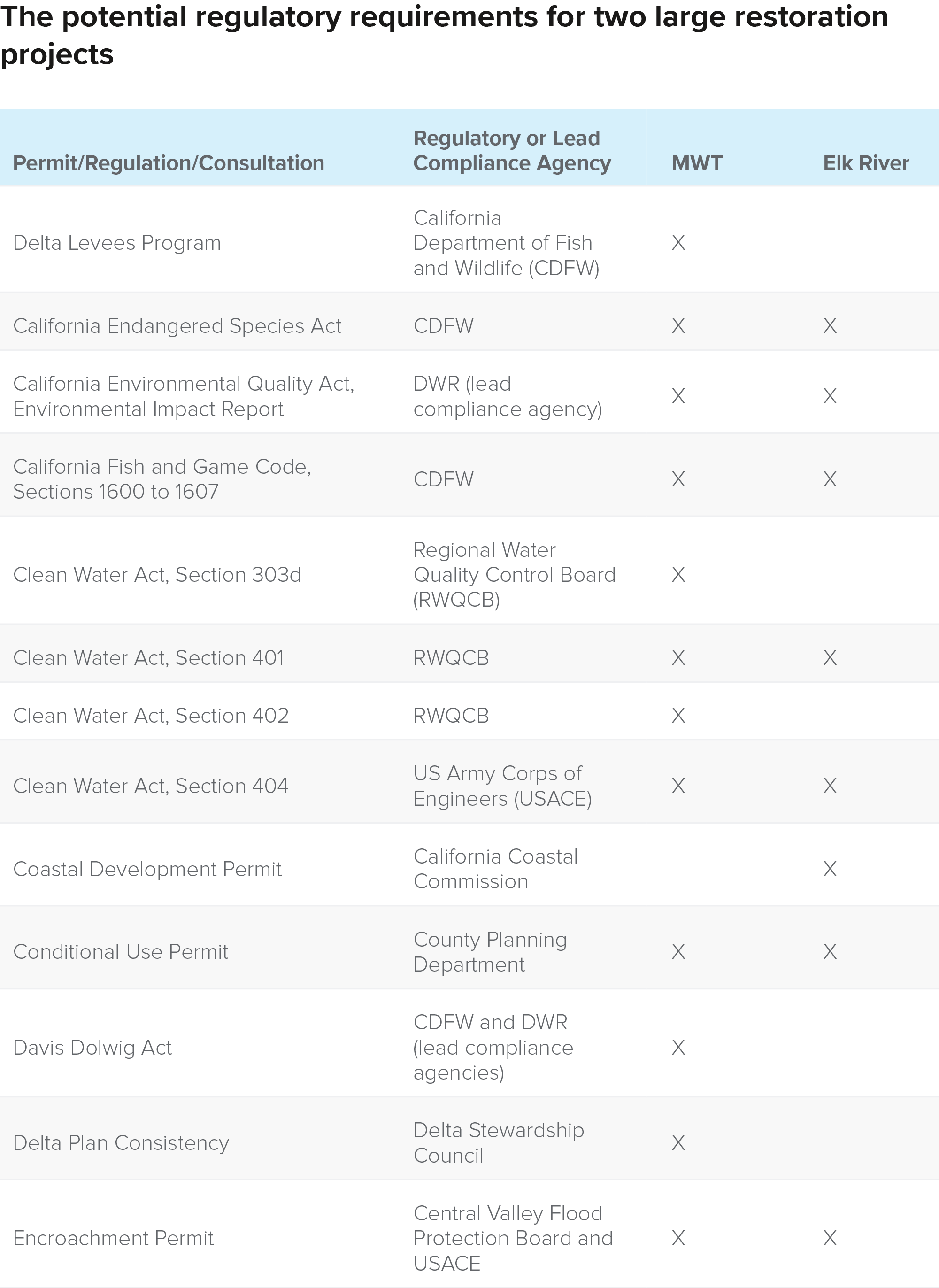

SOURCES: Pawley (2012) in Gray et al. (2013); CalTrout, personal communication.
NOTES: MWT is the McCormack-Williamson Tract.
McCormack-Williamson Tract
The McCormack-Williamson Tract lies downstream of the confluence of the Cosumnes and Mokelumne Rivers in the northeast Sacramento–San Joaquin Delta. Historically a freshwater tidal marsh, the island was reclaimed for agriculture decades ago. The Nature Conservancy (TNC) intended to restore 1,600 acres to freshwater tidal marsh and floodplain as part of the Department of Water Resources’ (DWR) North Delta Flood Control and Ecosystem Restoration Project. Project goals included:
- improving flood control to reduce damage from levee overtopping caused by insufficient channel capacities and levee failures,
- benefitting native species by re-establishing natural ecological functions and habitats,
- contributing to scientific understanding of ecological restoration, and
- enhancing public recreational opportunities without compromising flood protection infrastructure (California EcoRestore 2010).
Due in large part to a prolonged planning and permitting process and a change in land ownership, it took nearly a decade to break ground on the restoration. The project is large and complex, with landowner concerns about flooding of adjacent properties, impacts to protected species, and the need for compliance under a variety of sections of the CWA, as well as other regulations. For example, the potential change in the flood regime necessitated multiple hydrologic model iterations to support permitting for levee breaches as part of the restoration design. The possibility of flood waters mobilizing contaminants into the food web upon breaching, and a Delta Levees Program-specific requirement for mitigation, created significant unpredictability during planning (Pawley, personal communication). Uncertainty over the benefits of long-term restoration in light of a changing climate made permitting more difficult as well (Mount et al. 2015).
The issues surrounding designing a multi-benefit flood management and restoration project—and preparing for the sheer number and complexity of the project’s regulatory requirements—were a substantial drain on project resources. The change in land use (from agriculture with a low-lying levee berm to a tidal marsh) led to extensive discussions about mitigation requirements and increased cost projections. Although DWR analyzed the project as part of its 2010 environmental impact report (EIR) on North Delta Flood Control and Ecosystem Restoration, a supplemental EIR was necessary to support changes in the breach and grading design and new CEQA requirements. In addition, the restoration of the tract required permits, consultations, and demonstration of consistency with programs under at least 14 state, federal, and local agencies (Table 1). Project proponents needed to meet many of these requirements through separate processes, increasing costs for all parties and posing the risk that agencies would require inconsistent terms for approval.
Elk River Recovery Program
The Elk River in Northern California is a working landscape of farming, ranching, and redwood logging. The river is the largest tributary to Humboldt Bay and supports three runs of salmon. After its timber-rich upper watershed was heavily logged more than 20 years ago, storms washed huge amounts of sediment from clear-cuts into the river. Deposits of sediment in and along the river damaged salmon habitat and contaminated drinking water for local residents. Many of these deposits were colonized by willows, which slowed river flows, leading to increases in flooding of adjacent farmland, and contaminating drinking water for local residents. In 1998, the North Coast Regional Water Quality Control Board listed the river as sediment-impaired, setting the stage for the restoration work. The Elk River Recovery Program seeks to restore the beneficial uses protected by the CWA, including drinking water and salmon habitat. Restoration actions include dredging sediment from channels and removing vegetation to restore channel capacity. These actions aim to recover desired ecosystem functions, namely to increase coho and steelhead populations, reduce sea level rise impacts, improve drinking water quality, and reduce nuisance flooding (Pottinger 2021).
The program involves complex, often contradictory regulatory requirements (Table 1). For example, to mitigate impacts to willow thickets growing in the stream channel, which grew there as an unintended consequence of excess sediment from clearcutting, landowners may be asked to give up some of their property’s open space to allow mitigation for bird habitat that the willows now provide. Also, to restore fish habitat, the river flow has to be temporarily rerouted; capturing and relocating fish to enable this part of the project to go forward can count as an impact that must be mitigated under state and federal Endangered Species Acts (ESAs).
Originally, restoration practitioners sought permits for individual habitat restoration projects, but this piecemeal approach brought challenges with reconciling permit requirements across the different components of the landscape. These difficulties helped prompt a shift to a strategy incorporating habitat restoration benefits in other areas of the watershed to offset impacts. Thus, the project is now balancing impacts in degraded areas with habitat restoration in nearby high-priority locations (e.g., in the estuary) or in locations that are acceptable to landowners. As Darren Mierau, CalTrout’s North Coast regional director, sees it, “The main issue is the restoration or rehabilitation actions proposed to address prior legacy sediment impacts themselves cause temporary impacts, and agencies then require mitigation for these new impacts.” In other words, project proponents find that even though their project is restoring ecosystem functions after clearcutting created environmental problems, they have to mitigate both for temporary impacts of the restoration and for removing the sediment that caused the problems (and also created bird habitat). In this way, restoration projects have to unravel cascading effects, which is complicated and costly.
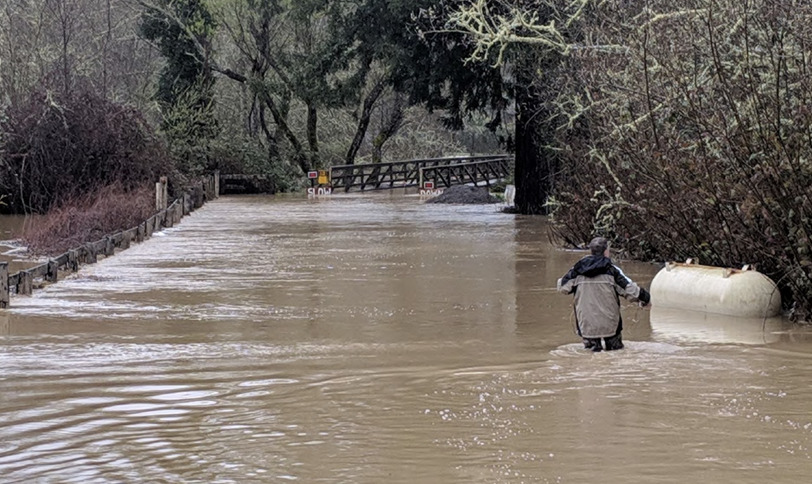
Nuisance flooding has plagued residents near the Elk River for more than two decades
PHOTO CREDIT: Darren Mierau.Defining Smarter Permitting
We used experts’ concerns about the current permitting process to identify criteria for smarter permitting. Project proponents who want to implement restoration work point to the time, effort, cost, and headaches of an overly complicated permitting process. Scientists and some regulators largely agree and advocate for more coordinated restoration at the landscape scale to increase desired ecosystem functions, such as supporting endangered wildlife or improving water quality (Mount et al. 2019). Based on this input, we used the following criteria to identify case studies that exemplified smarter permitting:
- Less time to permit restoration projects. It can take over a year to complete the permitting phase of a small restoration project (Task Force on Removing Barriers to Restoration 2002), and larger projects may take a decade or more (see McCormack-Williamson Tract above). These timelines are a major impediment. Furthermore, as climate change is already beginning to impact the state, ecosystem improvements are urgently needed. For example, the Bay Area aims to restore 100,000 acres of tidal marsh (Goals Project 1999), with as much restoration as possible completed by 2030, before sea level rise makes restored marshes less resilient (Goals Project 2015).
- Fewer costs in government staff time or in money spent on permitting by project proponent. Substantial staff time is spent on a cumbersome process involving multiple, sometimes conflicting, permit requirements. This translates into high costs for both the regulatory agency and project proponent (Hanak et al. 2013). Actions that simplify the process and lower the cost of permitting could leave more dollars available for the actual restoration work.
- More acres permitted. California has lost many of its natural habitats; for example, only about 10 percent of historical wetlands remain today (California Natural Resources Agency 2010). Also, restoring landscapes at ecosystem scale can help deliver more benefits from those ecosystems (see next bullet). Many thousands of acres need to be restored to replace some of California’s lost and degraded ecosystems and their benefits.
- More effective restoration projects that better deliver ecosystem functions. As habitat is lost, ecosystem functions and the services that they provide disappear, too. These valuable services include carbon sequestration, water quality improvement, and groundwater recharge, as well as recreation, commercial fisheries, and healthy populations of native fish and wildlife. Restoration projects should not only reassemble the ecological community that was previously there, but also ensure that the ecosystem’s essential functions are restored, which is critical to long-term success (Wright et al. 2009).
Defining Best Practices
We examined successful examples of smarter permitting initiatives. We held discussions with experienced leaders from nonprofits, government agencies, and science institutions working on better permitting for ecosystem restoration. We gathered information on many different efforts, casting a wide net for what might constitute smarter permitting, and ultimately identified the most promising projects for more in-depth study. We selected case studies based on the four criteria above and chose projects that represented diverse agencies and permits, geographic scope (Figure 1), ecosystem types, and permitting innovations. We also sought out examples that could offer insights for both project proponents and agency leadership and staff.
Representatives from each case study were invited to small workshops to share their knowledge with other leaders in this field. The representatives—all innovators in the area of smarter permitting—have pioneered new programs and strategies, often with demonstrated success. They discussed how their programs function, what improvements they contribute to the permitting process, how such improvements can be measured, and lessons learned. Workshop participants identified common links across the initiatives, especially in terms of which innovations were most important and other insights that could be translated into recommendations.
The case studies are listed here; three are described in depth in later sections of this report:
- Habitat Restoration and Enhancement Act (HREA): an expedited permit approval program of the California Department of Fish and Wildlife (CDFW) for small habitat restoration projects. Representative: Erika Lovejoy, Sustainable Conservation.
- Programmatic Biological Opinions for the North, Central and South Coasts, and Central Valley of California: programmatic authorizations of the National Marine Fisheries Service (NMFS) for impacts to protected fish species. Representatives: Bob Pagliuco and Evan Sawyer, NMFS.
- San Francisco Bay Restoration Regulatory Integration Team (BRRIT): a coordination program among seven agencies with jurisdiction over tidal wetland restoration in San Francisco Bay. Representatives: Amy Hutzel, State Coastal Conservancy, and Luisa Valiela, US Environmental Protection Agency.
- Upper Santa Ana River Habitat Conservation Plan (HCP): a conservation plan developed by the Upper Santa Ana River Sustainable Resources Alliance. Representative: Heather Dyer, San Bernardino Valley Municipal Water District (SBVMWD).
- Procedures for Discharges of Dredged or Fill Material to Waters of the State: a policy of the State Water Resources Control Board. Representative: Xavier Fernandez, San Francisco Bay Regional Water Quality Control Board (SFBRWQCB).
- South Bay Salt Pond Restoration Project: the largest tidal wetland restoration project on the west coast (15,000 acres), located in south San Francisco Bay. Representative: John Bourgeois, Valley Water.
- River restoration in the Central Valley and South Coast: an approach to restoring thousands of acres of river habitat in California. Representative: Julie Renter, River Partners.
Case studies included restoration efforts across much of California
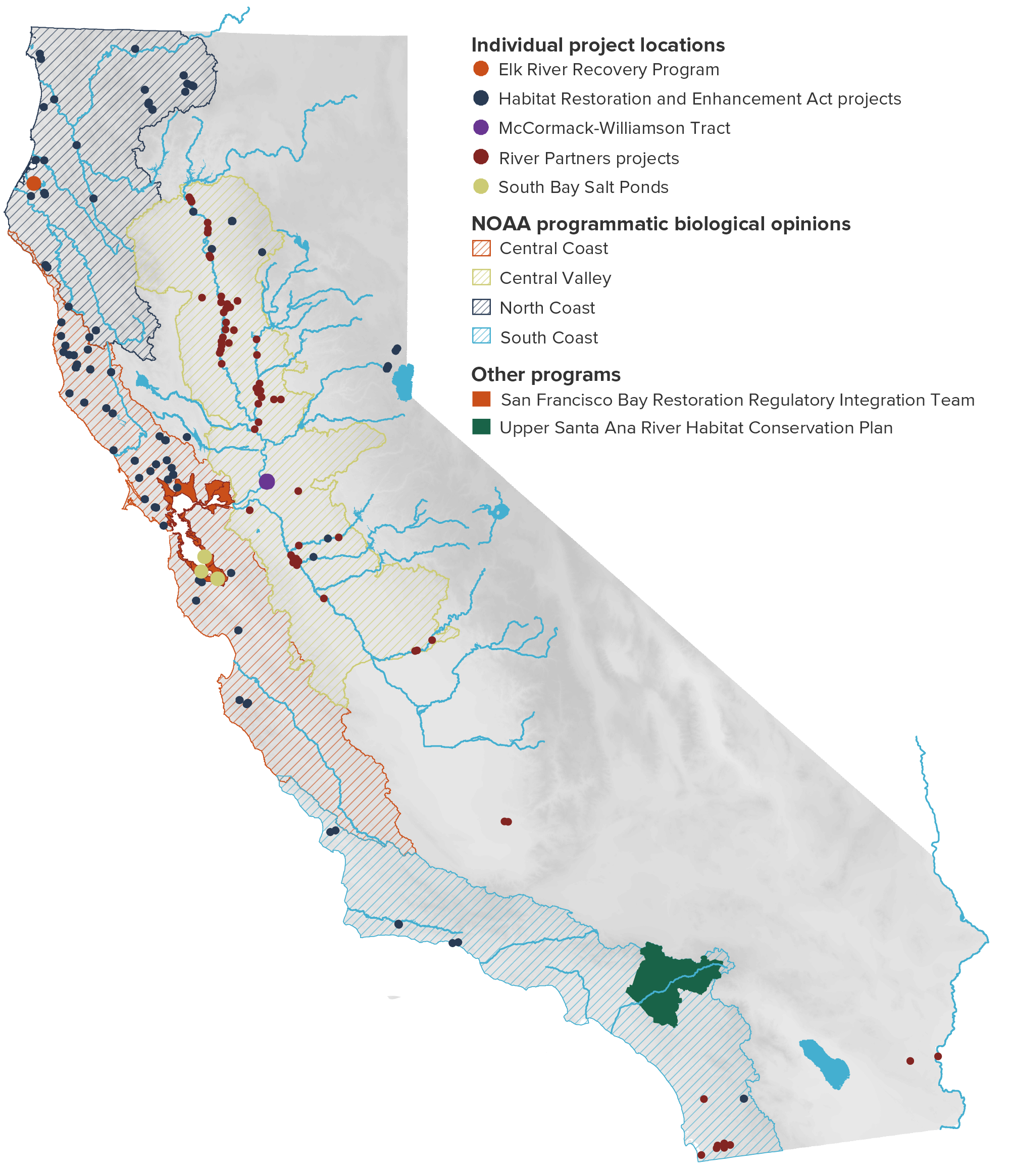
SOURCES: Created by authors using data from NMFS, CalTrout, Sustainable Conservation, San Francisco Estuary Institute, River Partners, and Upper Santa Ana River Sustainable Resources Alliance.
NOTES: The exact locations of dredge and fill mitigation projects were not available and could not be included in this map.
Dimensions of Smarter Permitting
Successful smarter permitting initiatives demonstrate commonalities in how they achieve efficiency and effectiveness. We found patterns in both the case studies that we explored in depth and other smart permitting processes we encountered in the course of our research. Three dimensions of smarter permitting emerged from these examples: coordinating across similar projects, coordinating within and among agencies, and permitting to achieve ecosystems that deliver higher levels of desired functions (called “functional permitting” here for brevity; Figure 2). We describe these dimensions in the following sections, with an in-depth discussion of one case study for each dimension.
Three dimensions can improve the efficiency and effectiveness of permitting to restore California’s ecosystems

Dimension 1: Coordinating across Similar Projects
The first and most established approach to smarter permitting in California involves coordinating permits and authorizations within an agency across similar projects. Often called “programmatics,” these initiatives feature blanket permits and authorizations that apply to many projects across a large area. To date, each programmatic covers projects of a certain resource type (for instance, streams or riparian forests, or a particular species or group of species) within an agency. By going through one of these programs, the applicant has a much lower burden of effort compared to a regular permitting process, namely:
- lower permitting costs (savings in fees, staff time, and/or consultant costs),
- a simplified process, and
- quicker permit approval.
While quantified tracking of the financial benefits for most smarter permitting programs is not readily available, the National Oceanic and Atmospheric Administration (NOAA) Restoration Center has estimated the cost savings from its programmatic biological opinions in California (Figure 3). These programmatic authorizations have saved an estimated $5–13 million in staff time and consultant fees for NMFS, USACE, and project proponents combined (Pagliuco and Samonte 2015). This shows how programmatic authorizations or permits can enable private landowners and other entities to engage in restoration without needing extensive time and money to permit those actions. Therefore, permits and authorizations that coordinate across similar projects meet our criteria for efficiency in time and cost, and likely enable more acres to be restored by lowering the permitting barrier.
Cost savings from the NMFS programmatic biological opinions have ballooned as more regions and projects gain approval
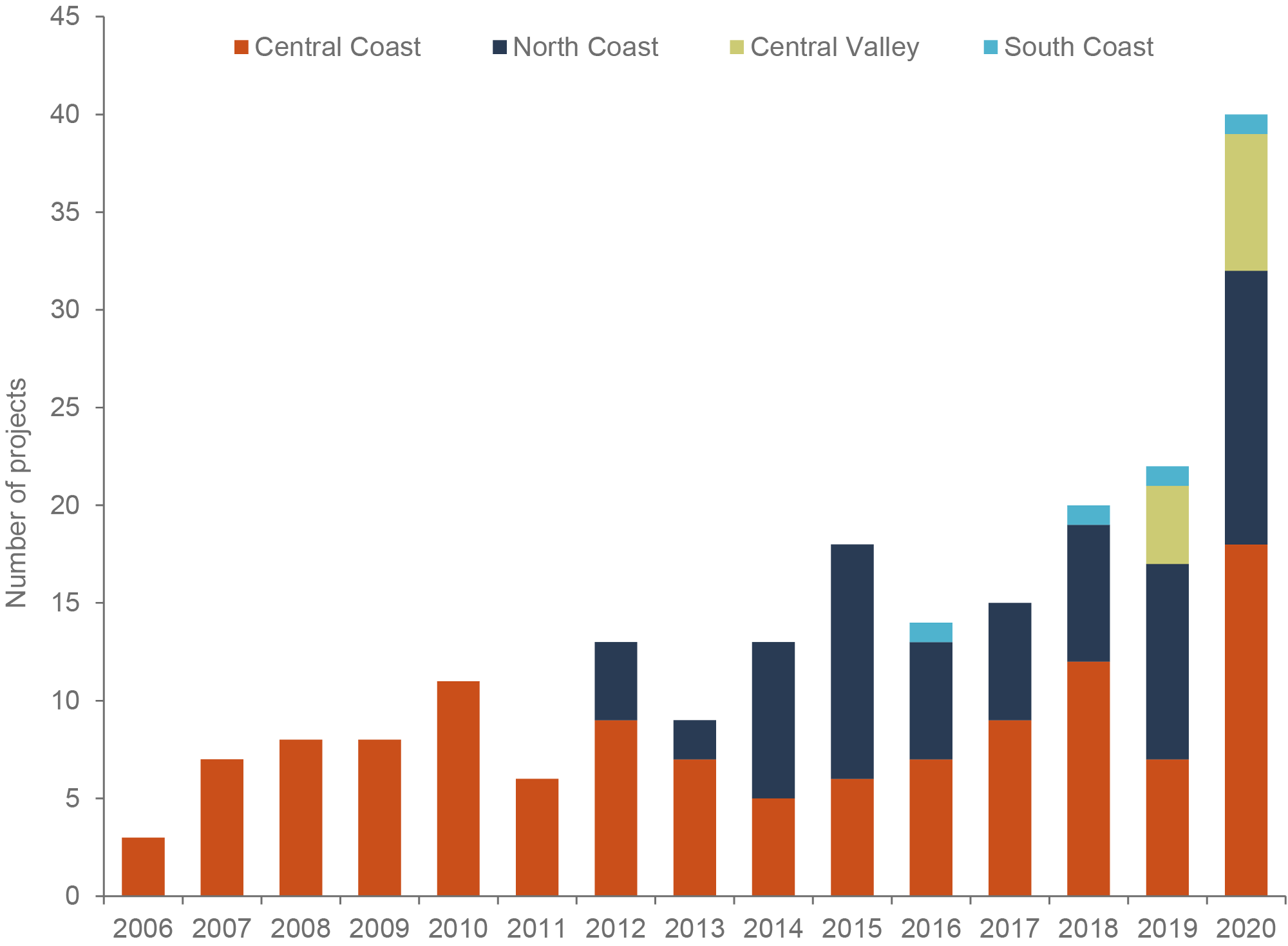
SOURCE: NMFS, personal communication.
NOTES: The total estimated cost savings for 207 projects is $5.1–13.2 million. For the geographical extent of the regions, see Figure 2.
In addition to these benefits, programmatic permits and authorizations and other expedited permitting processes for restoration, such as the Habitat Restoration and Enhancement Act (HREA), offer other advantages. Such initiatives allow agency staff to engage in the upfront planning of one program that will then pre-align the many applications that come through that program. By looking at the program requirement details, project proponents can develop and design projects that align with the agency’s plans for the ecosystem type in question. This reduces the back-and-forth communication needed to ensure that the project conforms to regulatory requirements. It can also align projects with, and track the incremental progress toward, other agency goals, such as high-leverage actions to promote the recovery of endangered species. Thus, such pre-application alignment may help restore higher levels of ecosystem function while saving time for both permitting agencies and permittees. For under-resourced agencies, such as CDFW, this extra time is invaluable; it allows staff to work on other priorities, including permits for large and complex restoration projects that might have significant environmental benefits. Second, such programs create a collaborative process in which agency staff may help the project proponent take advantage of the program because it is mutually advantageous. This is a critical cultural shift that we discuss later in this report.
Several programs in California coordinate restoration permits and permitting approval across similar projects, and their numbers keep growing. Sustainable Conservation has championed programmatic approaches and other efficient permitting processes across various regions, habitat types, and permit types, in partnership with regulatory agencies. The HREA (case study to follow) and Statewide Aquatic Habitat Restoration Permitting Initiative are two key examples, and a longer list of habitat restoration programmatics is maintained online (Sustainable Conservation 2020). The success of the NMFS programmatic biological opinion for California’s Central Coast (Figure 3) led to similar efforts in three other regions of the state (Figure 1). The Cutting Green Tape report on regulatory efficiencies recommends several ways to build out this dimension of coordinating permits across similar projects (California Landscape Stewardship Network 2020).
Case Study: Habitat Restoration and Enhancement Act
Overview
The Habitat Restoration and Enhancement Act (HREA), enacted in 2014, simplifies CDFW’s permitting process for small-scale (limited to five acres or 500 linear feet) voluntary restoration projects. Many landowners and environmental advocates seek to participate in the restoration of California’s threatened or endangered species and impaired waters, but they often don’t have the time or resources to obtain separate permits from eight or more agencies (Sustainable Conservation, n.d.). By simplifying the permitting process, the HREA makes projects more feasible.
Innovation and efficiency
The HREA includes lower fees for project proponents, faster turnaround times for permit decisions, and a reduced burden in terms of other related permits (California Department of Fish and Wildlife, n.d.). Permits are approved within 30–60 days instead of many months, which saves permittees money as well as time. Pre-application consultations allow permittees to engage in dialogue with CDFW early in the planning process. Pre-consultation helps avoid incomplete approval requests or delays, and can help protect sensitive wildlife species. Approved restoration and enhancement projects do not require additional permits from CDFW, such as a Lake and Streambed Alteration Agreement or a California Endangered Species Act (CESA) permit. The HREA also allows monitoring plans and reports from other permits to satisfy its monitoring requirements. By reducing the time and cost of permitting restoration projects, and by simplifying the process, it is likely that HREA is also enabling more acres of restoration to occur.
Lessons learned
CDFW staff noted that they experienced a learning curve with the HREA, and its use has evolved over time. The program incorporated more projects as regional staff grew more accustomed to the act, and the applicants learned how to better navigate the system. Better applications resulted in less work, expanded HREA approvals, and better coordination with other agencies. The HREA prompted CDFW to rethink restoration permits and generated new ideas about how to consider potential impacts to protected species in restoration projects. The success of HREA inspired CDFW to pursue other smart permitting initiatives, such as a potential Restoration Management Permit, which would address fully protected species and scientific collection permitting. CDFW staff emphasized the value of multi-project permitting across an entire watershed; it helps achieve ecosystems that better support wildlife species of interest and provides other desired functions. Such large-scale permit coordination allows staff to identify an overall goal, short- and long-term benefits, and the types of projects that will move forward.
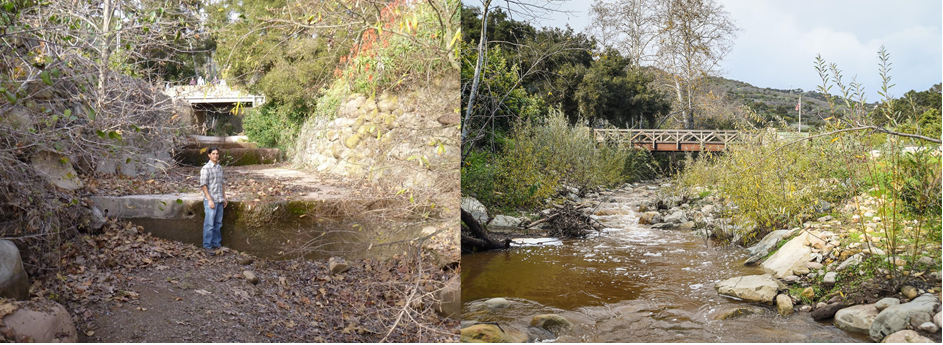
Carpinteria Creek, before and after restoration permitted under HREA
South Coast Habitat Restoration and Sustainable Conservation (left); Chuck Gardner and Sustainable Conservation (right). NOTES: The removal of the final barrier to fish migration allows federally endangered Southern California steelhead to reach spawning and rearing habitat in the upper watershed. Mauricio Gomez is pictured in the photo on the left, taken in 2013; the photo on the right was taken in 2017.Dimension 2: Coordinating within and among Agencies
The second dimension of smarter permitting involves coordinating within and among agencies. Each restoration project requires the approval of multiple agencies (Table 1, above), typically with little or no interagency coordination. This often results in conflicting requirements, which is confusing and time consuming for the applicant. Project proponents must spend scarce resources learning to navigate the timelines and requirements of each permitting agency; additional time is lost (and money spent) on finding solutions if agency requirements conflict with each other. While project champions are motivated to get permits, they often lack inside knowledge of an agency’s organizational structure, processes, and culture. This outsider status makes it inefficient for the permittee to find a compromise that works for all the agencies involved. Within agencies, groups tasked with regulation and restoration or recovery are often siloed, and would also benefit from increased coordination.
The lack of coordination within and among agencies may result in fewer acres devoted to restoration. In addition to impacting these criteria for smarter permitting (time, cost, acres), the lack of coordination among agencies also affects functional permitting. Large, complex projects, which are likely to deliver more beneficial ecosystem functions, are often the most impacted by the challenges of reconciling requirements across many agencies; the McCormack-Williamson Tract and Elk River projects are prime examples of this.
Coordinating among agencies resolves this problem by having agencies work in partnership with each other, rather than de facto requiring the permittee to do so. Some of our case studies illustrate the benefits of this approach. First, innovators found that, by working together, the agencies with jurisdiction learned about the goals and requirements of other agencies. This allowed agency staff to view the process from the perspective of a permittee, which was important for devising solutions to conflicts between different agency requirements. Second, agency alignment created a culture of teamwork among agencies, which improved the working relationship with permittees as well. This cultural change can help shift the norm from a permit process that inhibits restoration projects to a process that refines them. In the latter case, the agency’s environmental goals are still influencing outcomes, but the projects should face an easier path to implementation, hopefully resulting in both more acreage restored and better ecosystem function on that acreage. Altogether, these changes developed trust among agency staff, which helps regulators feel that they can experiment and use innovative approaches to tackle urgent environmental problems through the lens of permit authority. Last but not least, this coordination is designed to ultimately save time and money for both regulators and project proponents.
Examples of coordination within and among agencies are growing in number, although they seem to be less common than programmatic permits and authorizations that coordinate across similar projects. The Bay Restoration Regulatory Integration Team (BRRIT) has been operating for just over a year, with a structure aimed at aligning agencies with each other and with project proponents during the pre-application consultation phase (see case study below). The BRRIT functions at two levels, with managers discussing how to reinterpret policies to address novel challenges (like needing to fill tidal wetlands to help them keep up with sea level rise) and with permit analysts working directly with project proponents. Also, in its work to restore Central Valley and South Coast rivers, River Partners employs a strategy of intra-agency coordination by aligning projects with the restoration branch of an agency that also has regulatory authority over the project. This incentivizes the agency to authorize the project because it will meet the agency’s own restoration goals. The Cutting Green Tape report also recommends interagency cooperation, such as consolidating a single permit application for projects that are eligible for both HREA and the Small Habitat Restoration Program (California Landscape Stewardship Network 2020).
Case Study: Bay Restoration Regulatory Integration Team (BRRIT)
Overview
The BRRIT officially began to coordinate permitting among agencies for multi-benefit wetlands restoration projects in San Francisco, San Pablo, and Suisun bays in August of 2019 (San Francisco Bay Restoration Authority 2018). The BRRIT was created to meet the need for faster permitting to support a larger set of projects funded through the San Francisco Bay Restoration Authority (Authority), following the passage of the San Francisco Bay Clean Water, Pollution Prevention, and Habitat Restoration Measure (Measure AA) in 2016 (San Francisco Bay Restoration Authority, n.d.b). These projects typically require permits from six agencies (USACE, USFWS, NOAA, SFBRWQCB, CDFW, San Francisco Bay Conservation and Development Commission), which can take years to be approved. The BRRIT is designed to improve the permitting timeline by aligning agencies during pre-application consultation and the actual permitting process. The program offers pre-application meetings, site visits, and written guidance to restoration projects before they submit formal permit applications. A team of permit analysts from the six agencies reviews project information collaboratively with applicants, identifies potential issues early in the design and planning process, and provides recommendations to meet agency requirements. The BRRIT is funded by the Authority, as well as by Valley Water, East Bay Regional Park District, Bay Area Toll Authority, and the Coastal Conservancy. A Policy and Management Committee is made up of managers from these six agencies as well as the US Environmental Protection Agency, which also has jurisdiction under Section 401 of the Clean Water Act. The committee meets monthly and coordinates with the permit analyst team to resolve policy issues that may otherwise delay permit decisions (San Francisco Bay Restoration Authority, n.d.a).
Innovation and efficiency
The BRRIT’s pre-application focus allows project proponents and regulatory agencies to identify conflicts between different agencies’ requirements early on, and determine how to resolve them before proponents submit applications. This early alignment is meant to create efficiencies at later stages in the process. The BRRIT has established agency response deadlines for each step in the permit application process, and the agencies coordinate with each other throughout (San Francisco Bay Restoration Authority 2018). This structured approach could greatly reduce permitting timelines for tidal marsh restoration projects, from many years to perhaps just months in some cases. Given that the first three BRRIT projects were too far along in development to benefit from the pre-application consultation (which is the core efficiency of the BRRIT), it is too early to track metrics of success (San Francisco Bay Restoration Authority 2018). If projects are indeed permitted more quickly, more acres of marsh can be restored in the next decade. This would allow the marshes to gain the elevation needed to better withstand sea level rise, which is expected to accelerate after mid-century. Thus, the BRRIT’s coordination among agencies is designed to meet the criteria for smarter permitting: saving time and money, restoring more acres more swiftly, and creating marshes that offer more desired ecosystem function (resilience to sea level rise).
Lessons learned
Allocating staff from different regulatory agencies to work together, rather than separately, creates benefits beyond those described above. The six BRRIT permit analysts are learning about the procedures and requirements of all the other agencies; this knowledge puts them in a strong position to improve the permitting process. Further, this interagency learning environment has fostered a culture of teamwork among the permit analysts, who share the goal of successful restoration and are shifting away from the cultural legacy of permits inhibiting projects. At the management level, a separate team works to address policy issues, including a more flexible interpretation of regulations for restoration projects. For example, the Policy and Management Committee has explored how to allow restoration projects that may cause limited take of endangered species in the short term but will improve conditions in the long run for species that are highly vulnerable to climate change. Lessons learned are captured in annual reports to the Authority, and a Permit and Policy Improvement List focuses on increasing efficiency in permit review and resolving policy issues that limit flexibility in the design and permitting of multi-benefit restoration projects. At least one initiative on this list will be improved and implemented annually. Thus, the BRRIT has integrated an adaptive management approach that should help update regulatory policy interpretations as the climate changes.
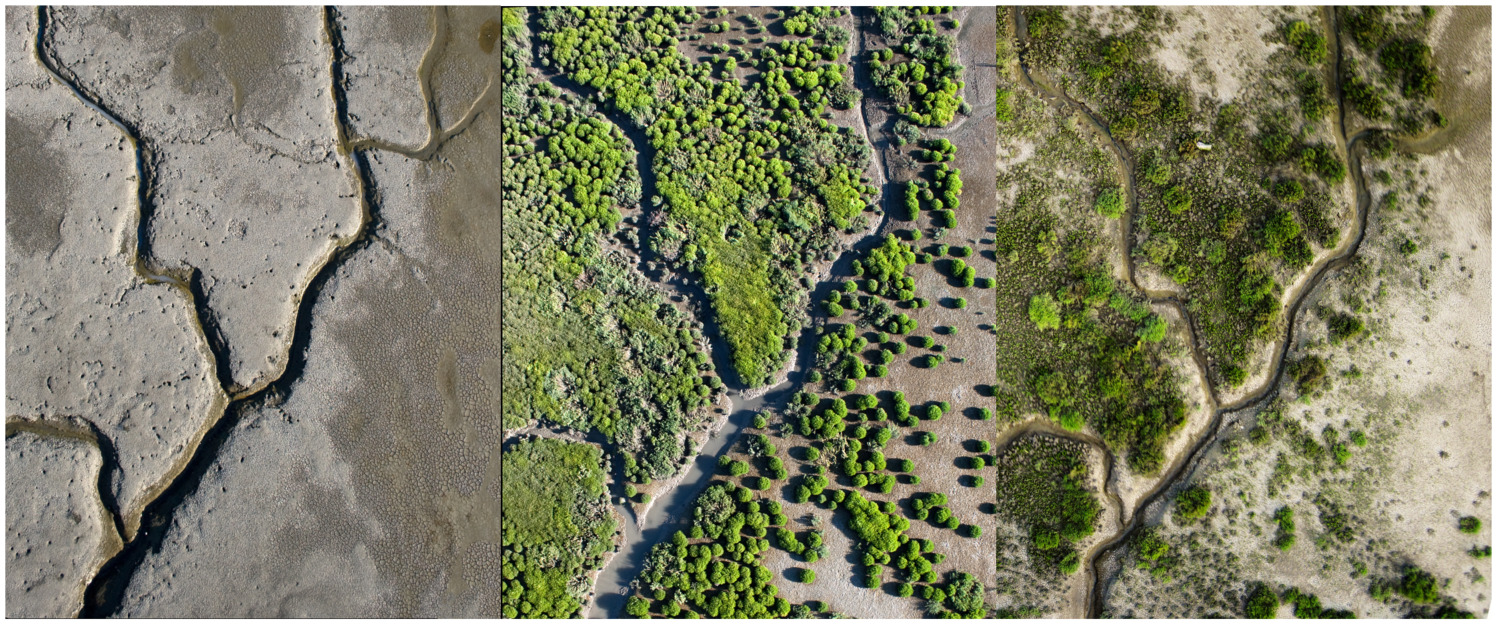
The South Bay Salt Pond Restoration Project exemplifies the large-scale, high-impact ecosystem improvements that the BRRIT could accelerate
PHOTO CREDIT: Cris Benton. NOTES: Many thousands of acres are slated for wetland restoration and enhancement within the South Bay Salt Pond Restoration Project. Island Pond A21, pictured here, evolved from lacking vegetation prior to restoration in 2008 (left), to being colonized by annual pickleweed in 2009 (center), then transitioning to more perennial wetland plants in 2010 (right).Dimension 3: Functional Permitting
The third dimension of smarter permitting involves approaches that create ecosystems that provide higher levels of desired functions. This dimension includes a varied set of efforts to manage for ecosystem functions across large geographic areas and over longer periods of time. Permitting processes at the landscape scale can optimize for different functions in different parts of a large ecosystem, thus accommodating multiple needs for both people and wildlife. By planning and coordinating so that the system works better as a whole, and considering benefits over longer timescales, the net benefits are greater than independent projects can provide (Delacámara et al. 2020). Permitting at the scale of individual projects may be appropriate where the goal is to minimize negative impacts to larger, more intact ecosystems. But given the current state of California’s landscapes, where natural processes have been highly altered and ecosystem functions greatly reduced (Mooney and Zavaleta 2016), functional permitting is an indispensable approach for rebuilding ecosystems that provide desired benefits.
Many functional permitting examples arose from situations in which a new approach was needed to move projects forward. In these situations, innovative leaders found a way to balance the many functions desired from particular ecosystems, bringing stakeholders together to manage the landscape jointly. Such an inclusive approach, with all stakeholders and sectors at the table, is essential when permitting at the ecosystem scale; the undertaking is very large, and all parties need to understand the ecosystem’s many desired functions. Indeed, it may be necessary to pool resources from many different entities to enable functional permitting to succeed. Ecosystem-scale permitting also demands a foundation of shared scientific knowledge. This common basis of understanding can help facilitate decision-making through adaptive management and create trust among stakeholders. Functional permitting does not necessarily create immediate cost savings, faster restoration, or more restored acres, in part because it involves long-term planning over large geographic areas, with many stakeholders. However, in the examples we studied, this approach enables restoration to proceed in difficult situations, facilitating a critical shift from no restoration to landscape-scale restoration. This approach is likely to become increasingly important as the impacts of climate change (such as reduced water supply and increased coastal flooding) create more seemingly intractable ecosystem management challenges.
We found several examples of regulatory agencies and project proponents working together to create more functional permitting. HCPs and Natural Community Conservation Plans (NCCPs) better allow for managing ecosystems at large scales for multiple species. The Upper Santa Ana River HCP came out of a partnership that brought stakeholders together when the needs of people and protected wildlife could no longer be resolved at the project scale (see case study below).
Similarly, the South Bay Salt Pond Restoration Project highlights advances in designing ecosystem restoration to meet multiple, seemingly competing objectives. The project was tasked with balancing the needs of different wildlife species that could not be resolved with static restoration acreage targets. Wildlife conservation advocates and scientists were concerned that too much tidal marsh restoration, which would help recover endangered marsh wildlife, might overly impact the waterbirds that relied on the existing salt ponds. The solution involved flexible permits that allowed a restoration goal of between 50 percent and 90 percent of the tidal marsh, with the final amount determined over time, using a science advisory group and adaptive management. This novel agreement allowed the project to move forward, with thousands of acres of tidal wetlands restored to date, including marshes that support endangered birds and mice (South Bay Salt Pond Restoration Project, n.d.).
Finally, the State Water Resources Control Board’s new dredge and fill procedures demonstrate innovation in using ecosystem-scale data to guide mitigation permitting. The new procedures require mitigation projects to be permitted in the watershed context (State Water Resources Control Board 2020). Project proponents must develop a watershed profile that identifies the extent and condition of wetland and creek resources within the watershed where mitigation would occur. Such a profile allows project proponents and regulatory agencies to design mitigation actions that create the most functional improvements for the ecosystem. For example, if the watershed profile shows that increasing the buffer areas around vernal pools is more important to supporting endangered species than creating more vernal pools, mitigation can focus on the former.
Case Study: Upper Santa Ana River Habitat Conservation Plan
Overview
In Southern California, the Upper Santa Ana River watershed is highly urbanized. The water supply portfolio—which serves several cities, agricultural areas, and groundwater recharge sites—includes local river flows, discharge from several wastewater treatment plants, and imported water from less arid areas. The growing population places an increasing human demand on limited water supply. The watershed is also home to a number of threatened and endangered species; local water suppliers must acquire permits from CDFW and USFWS for each new project. In particular, the Santa Ana Sucker (Catostomus santaanae), a federally threatened fish, was at the center of lawsuits between regulators and water users. Additional conflicts have arisen over water quality management, creating added frictions with regulators and conservation groups, and also pitting different local agencies against each other. Piecemeal attempts to solve these problems individually, project by project, led to a stalemate. In 2014, 11 local water supply agencies came together with CDFW and USFWS to form the Upper Santa Ana River Sustainable Resources Alliance (Alliance) to develop solutions (Upper Santa Ana River Sustainable Resources Alliance, n.d.). The result of this novel collaboration was the Upper Santa Ana River HCP. The HCP is a fully integrated environmental compliance program that balances human water needs with environmental protection by managing for key ecosystem functions at a large scale. This happened because the many Alliance partners united their efforts across the watershed (Mount et al. 2019). An independent science advisory team supplies the best available science to craft the HCP and build an adaptive management plan.
Innovation and efficiency
The landscape scale of the HCP enables “trading off” beneficial uses across the watershed in order to increase net benefits for wildlife conservation and a reliable water supply. Prior to the HCP, the projects were too small and uncoordinated to create a functional ecosystem that could recover protected species to levels that would allow some take, or impacts, as defined by state and federal ESAs. As a result, permitting for water projects ground to a halt. The watershed-scale HCP opens more possibilities for both water users and regulatory agencies to meet critical goals. Despite some compromises, each stakeholder gets a net benefit, largely by trading functions across space. For example, one partner reroutes water to support fish and is compensated when other partners place water that is less useful for fish above the first partner’s municipal wells. “Through a series of such trade-offs, each partner is eventually made whole, which builds trust in the partnership,” noted Heather Dyer of the SBVMWD. The HCP (in draft form at the time of writing) will be successful if it conserves wildlife species and habitats while providing reliable water for people in the watershed. Because the HCP covers activities by multiple water resource agencies at the scale of the larger ecosystem, individual actions and projects can be designed to add up to a more functional ecosystem with greater net benefits. The plan includes habitat acreage goals and adaptive management. Monitoring for the effectiveness of restoration is an integral component, including tracking streambed elevations, streambed materials, presence of protected species, and fish populations. The HCP will save time for project proponents as they develop their permit applications and for agencies in their review process. Notably, an evaluation of the cost effectiveness over a 50-year period projected net savings of $952 million (net present value), which will be passed on to water users in the form of lower water costs (ICF 2020).
Lessons learned
This effort in the Upper Santa Ana River watershed highlights key components of permitting that can achieve improved ecosystem function, particularly over a large geographic area. The first is partnership at the watershed scale: in trying to balance multiple water management needs in an arid climate, Alliance partners found that working together at the watershed scale was the most successful way to share limited resources. Second, shared goals are essential: the Alliance took measures to include water users and ecosystem restoration advocates and seek alignment between them. The goal of ecosystem restoration was too big, complex, and expensive for any single entity to undertake successfully; the full coalition of partners was essential. Third, the Alliance learned about the challenges each partner faced, which developed mutual understanding and respect. In the process of developing this solution together, the partners identified a major gap in the current state of regulation. Permitting to prevent extinction project by project is not very effective for recovering threatened and endangered species. To achieve recovery, the ecosystems that support these wildlife need to be more functional overall. Regulators could promote the restoration of ecosystem functions (such as supporting protected species) by using landscape-scale permitting initiatives. And finally, science has played an integral role in developing the HCP, and will continue to do so as it is implemented. Early in the process, the science advisors helped to create a shared understanding of unbiased data. The science-based adaptive management plan is now helping to build trust among the partners and guide decision-making. All these elements of the HCP (partnering at the watershed scale, a shared goal of resource recovery, developing respect and trust, and using independent science) enabled the Alliance to end long-standing gridlock while permitting for a more functional ecosystem.

The Santa Ana River flows through a heavily modified watershed that is home to threatened and endangered species such as the Santa Ana Sucker
PHOTO CREDIT: Joanna Gilkeson at US Fish and Wildlife Service.Important Takeaways
The case studies of successful smarter permitting initiatives have many threads in common. In addition to the three dimensions of smarter permitting discussed above, our investigation elucidated several takeaway messages that could inform efforts to improve California’s environmental permitting system.
Project Proponents Can Initiate Smarter Permitting Approaches
Nearly every case study of successful smarter permitting started as a grassroots endeavor led by restoration proponents, whether they were nonprofit organizations, government agencies, or water users. Only the State Water Board’s dredge and fill procedures were initiated by a regulatory agency. Regulatory agencies played a key role in all the case studies, of course, by partnering with the organizations that championed new permitting approaches and doing the work to change their processes. This pattern is significant, because it means that project proponents can help reform permitting approaches, although it may require extensive coordination and fundraising, as well as exceptional leadership. It also means that government agencies can provide more innovation and leadership in this area, including by partnering with external restoration champions. Hopefully, the Cutting Green Tape initiative will provide regulatory agencies with the resources necessary to achieve such outcomes.
Key Takeaway: Project proponents have created their own smarter permitting initiatives, with partnership from regulatory agencies.
Coordinating at the Ecosystem Scale Can Help Reconcile Multiple Objectives
Coordinating at the ecosystem scale is an efficient and effective approach to restoration when there are multiple, often competing objectives. Trading off desired ecosystem functions across locations allows a project to address the needs of most stakeholders. This has proven critical for unblocking restoration processes, notably for the Upper Santa Ana River HCP and South Bay Salt Pond Restoration Project. This approach requires coordination and cooperation across different agencies and constituencies, and demands knowledge grounded in independent science and local, place-based expertise. Large-scale restoration can also deliver greater net benefits, because it matches function with scale. Ecosystems have many parts that work together across large geographic areas. Managing the parts of the system as a whole in a coordinated way, rather than as many one-off projects in different parts of the system, is akin to designing all the parts of a car to work together rather than designing them separately without coordination. Large-scale and long-term coordinated restoration will not be needed everywhere, but it may help restoration projects move forward in particularly challenging situations. To get better results, interagency teams could coordinate at the watershed scale to permit restoration projects, using efficient permitting mechanisms. Interagency teams could also counsel stakeholder groups who are interested in setting up their own large-scale permitting initiatives for restoration, so that each region does not have to reinvent the wheel. Creating such change would require significant up-front work by project proponents, clear directives from regulatory agency leadership, and support from the governor and legislature, including dedicated funding.
Key Takeaway: Coordinated permitting at the ecosystem scale can unblock projects by trading off desired ecosystem functions in different locations.
An Inclusive Process Helps Resolve Management Conflicts
Across the board, the permitting programs we studied brought together many parties involved in restoration projects to jointly understand and address the complicated regulatory requirements. We particularly noted this inclusive approach to co-discover each other’s needs, challenges, missions, and procedures in the BRRIT process and the Upper Santa Ana River HCP. The investment of sitting down together, hearing each other, and undertaking collaborative problem-solving can develop buy-in and partnership among the stakeholders. Including everyone at the table also helps project proponents forge a common understanding, based on independent science, of how an ecosystem functions and how management actions can influence those functions. Individual projects likely would not have the resources to bring together all stakeholders in an inclusive process, with time to air and address all needs, and funding for targeted science. This is one reason why we need larger initiatives that span multiple projects, along with mechanisms to fund such processes. Inclusive processes should do more to involve local communities as stakeholders or partners, especially historically underserved low-income communities and communities of color, to benefit from their expertise and ensure their priorities help drive decision-making and equitable outcomes (Box 2).
Key Takeaway: To achieve successful outcomes, smarter permitting programs need to include as many stakeholders as possible.
Early Alignment Is a Wise Investment
Investing early in alignment among the many entities involved in ecosystem restoration also promotes successful outcomes. We found four notable ways that strategic alignments occurred. First, project proponents can align with each other as the collaborative process begins. When different stakeholders desire different (and potentially competing) ecosystem functions, it is essential to find solutions that meet the needs of many stakeholders and earn buy-in before pursuing permits. The South Bay Salt Ponds Restoration Project is a case in point. Second, proponents can align themselves with the goal of ecosystem recovery. The Upper Santa Ana River Sustainable Resources Alliance found that to implement water projects, protected species’ population levels need to be robust enough to allow for some impacts to species from project investments. This critical alignment helped water users and ecosystem recovery proponents work toward the same goal. Third, agencies can create better alignment where their processes and requirements are currently inconsistent. This was the key motivation behind the BRRIT’s pre-application consultation phase. By coordinating early in the process, agencies can resolve discrepancies in their requirements, reaching a clear plan with project proponents before they file the formal permit application. Finally, proponents can design projects that fit with the restoration goals of agencies that have permitting jurisdiction. Thus, the agency is incentivized to permit a project that meets its own targets. One way this can be accomplished is within programmatic permits and authorizations (like the NMFS programmatic biological opinions). All these types of alignments occurred early in project development, which created efficiencies for many of the parties involved as the work progressed.
Key Takeaway: Aligning can happen in a variety of ways, and putting effort into early alignment pays off as the work progresses.
A Culture of Trust Allows Flexibility and Change
A final, critical component of all smarter permitting initiatives entails developing a positive culture that builds mutual understanding and trust. Strong leadership, coupled with a commitment to inclusiveness, can help build such cultures. This enables the parties involved to innovate and find flexible solutions for difficult problems. Nearly all the smarter permitting programs we investigated created cultures of teamwork—whether it was regulatory agencies and permittees working together (HREA, NMFS programmatic BOs), water users working toward watershed-scale environmental restoration (Upper Santa Ana River HCP), or agencies with different jurisdictions working together (BRRIT). This teamwork involved learning together; getting to know and understand each other (including different goals, procedures, and requirements); investing in a collaborative process; and ultimately building the trust necessary to risk trying something new. Ecosystem stakeholders, including water users, regulatory agency staff, and fish and wildlife advocates, forged a common grounding in independent science and recognized their shared commitment to ecosystem recovery. Leaders in all sectors can incentivize teamwork and encourage innovation when permitting restoration projects. Agency staff need cover from leadership in order to apply their expertise with flexibility for restoration projects. Agency managers could reward staff who improve the permitting process for restoration projects, and the governor and legislature can help by providing clear directives to agency leaders to innovate in this way.
Key Takeaway: Cultures based on trust lead to innovation and success; strong leadership can help them develop.
Conclusion
Given the legacy challenges of environmental degradation in California, compounded by the urgency of the climate and biodiversity crises, smarter permitting for restoration projects is critical to restore more functional ecosystems quickly and efficiently. The state is addressing this challenge with an Executive Order focused on increasing climate resilience, conserving biodiversity, and implementing the Cutting Green Tape initiative (EO-N-82-20). We investigated smarter permitting programs that save money, implement restoration more quickly and extensively, and create ecosystems that provide desired functions.
We concluded that regulatory agencies could revamp restoration permitting to implement all three dimensions of smarter permitting described in this report. Agencies can coordinate permits and authorizations across similar projects, and among agencies, with a focus on creating higher levels of desired functions at the ecosystem scale. This could greatly improve the efficiency and effectiveness of restoration. The lessons described above should help stakeholders design such a permitting approach; namely:
- project proponents can initiate smarter permitting approaches,
- coordinating at the ecosystem scale can help reconcile multiple objectives,
- an inclusive process helps resolve management conflicts,
- early alignment is a wise investment, and
- a culture of trust allows flexibility and change.
While improving the permitting process for restoration projects is a difficult task, the examples collected here prove that it is possible. Indeed, not only is improving permitting possible, it’s absolutely vital in the coming decades. California relies on ecosystem functions and benefits to underpin the state’s economy and overall wellbeing. The people and wildlife of California need ecosystem restoration at scale and soon, so that healthy ecosystems can provide clean water, food, flood risk management, carbon sequestration, places to recreate and connect to nature, and other critical functions as the climate changes. For this reason, smarter permitting for environmental restoration is a core element of creating a better future California.
Topics
Drought Floods Freshwater Ecosystems Water Supply Water, Land & AirLearn More
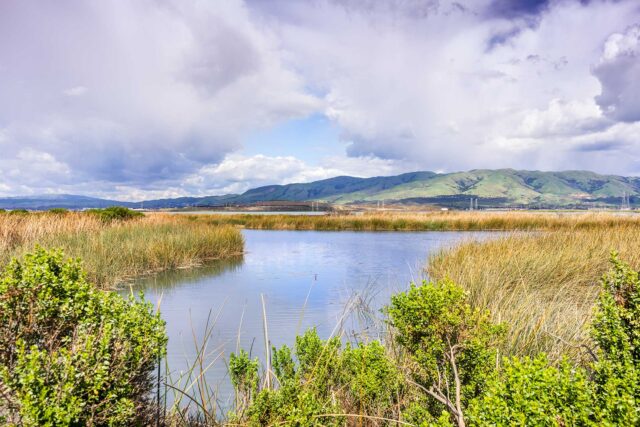
Commentary: To Restore California’s Ecosystems, We Must Adopt Smarter Permitting
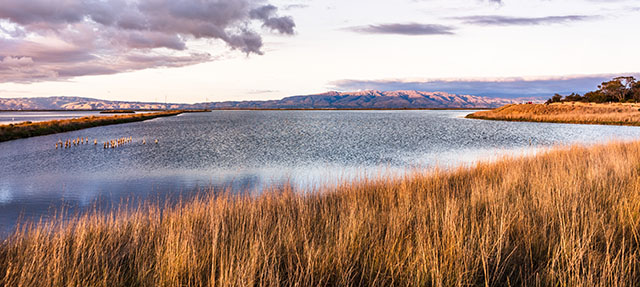
How Permitting Slows Ecosystem Recovery and Climate Resilience Projects
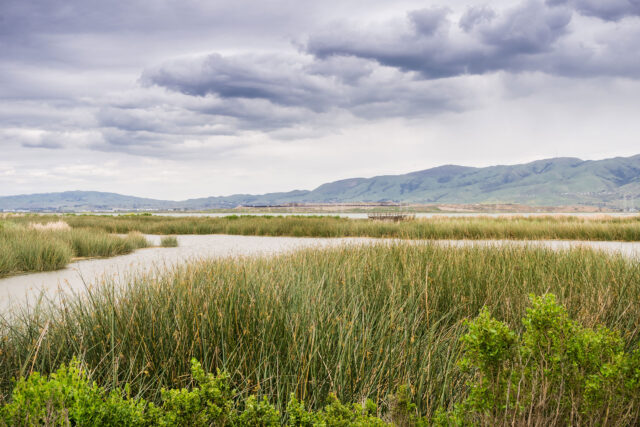
Policy Brief: Advancing Ecosystem Restoration with Smarter Permitting


